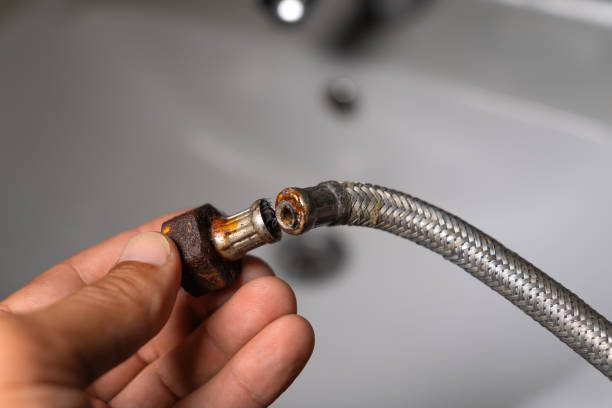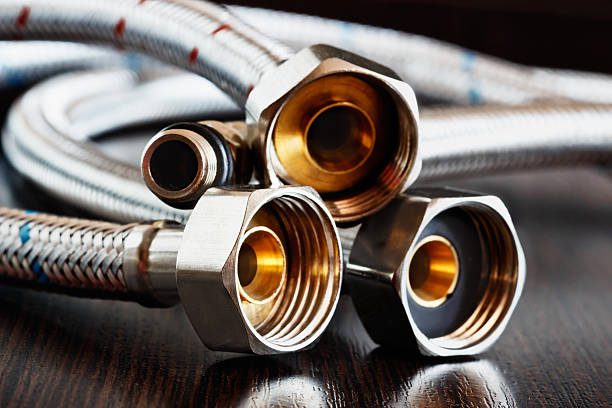Burst flexi hose troubles? How to tell if a flexi hose is about to burst?
What is a flexi hose?

A flexi hose, short for flexible hose, is a type of plumbing pipe commonly used to connect water supply lines to fixtures like sinks, toilets, and washing machines. It is made from a flexible, rubber or plastic inner tube encased in a braided stainless-steel or plastic exterior. The flexibility allows it to be easily bent or shaped, making it convenient for tight or awkward spaces where rigid pipes wouldn’t fit.
Flexi hoses come in different lengths and sizes and are usually equipped with metal or plastic fittings on both ends for easy installation. They are popular because of their ease of use, but they can wear out over time, leading to potential bursts or leaks if not maintained or replaced when necessary.
Where are you most likely to find them?
Flexi hoses are most commonly used in residential and commercial plumbing to connect water supply lines to fixtures and appliances. Some of the most typical uses include —
- Kitchen and Bathroom Sinks: Flexi hoses connect the water supply lines to faucets, making installation easier in tight spaces under the sink.
- Toilets: They are used to connect the water supply line to the toilet cistern, allowing for flexible positioning.
- Washing Machines: Flexi hoses connect washing machines to water inlets, accommodating the machine’s movement and placement.
- Dishwashers: They connect dishwashers to both water supply and drainage lines, offering flexibility during installation.
- Water Heaters: Flexi hoses are sometimes used for connections to water heaters where space or flexibility is required.
- Showers and Bathtubs: Flexi hoses can be used to connect water supply lines to showers or tubs, especially for retrofitting or repairs.
Their flexibility and ease of installation make them a popular choice in various plumbing setups, especially where space constraints exist. However, their frequent use in critical water supply points also makes regular inspection crucial to avoid failures like bursts.
How long does a flexi hose last?
A flexi hose typically lasts between 5 and 10 years, depending on factors like the quality of the hose, water pressure, and environmental conditions. However, it’s important to regularly inspect them for signs of wear, such as corrosion, bulging, or leaks, as they can fail unexpectedly, especially if they’ve been in place for a long time.
To prevent bursts or water damage, it’s a good idea to replace flexi hoses proactively every five years, even if they don’t show obvious signs of damage.


How can you tell if a flexible hose is about to burst?
To know if a flexi hose is about to burst, look out for these warning signs:
- Visible Wear and Tear: Check for any signs of rust, corrosion, or fraying on the outer stainless steel braid. These are indicators that the hose may be weakening.
- Bulging or Swelling: If the hose appears swollen or bloated in certain areas, it indicates pressure buildup inside, which often precedes a burst.
- Water Leaks or Dampness: Small leaks or moisture around the hose fittings or along the hose itself can signal that the hose is failing.
- Kinks or Bends: Flexi hoses are designed to be flexible but not excessively twisted or kinked. If the hose is bent at sharp angles, it may weaken the structure, leading to a burst.
- Age of the Hose: Flexi hoses typically last between 5-10 years. If the hose is older, it’s more prone to bursting, and it might be time to replace it.
- Strange Noises: Unusual hissing or whistling noises when water flows through the hose could indicate a problem with pressure or damage to the hose material.
- Loose or Worn Fittings: The connectors at the ends of the hose should be secure. If the fittings are loose or showing signs of deterioration, this could lead to leakage or a burst.
Regularly inspect your flexible hoses and replace them at the first sign of damage to prevent sudden bursts and potential water damage.
How can I prevent a burst flexi hose?
Regular inspections are essential to prevent a burst of the flexi hose. Frequently check the hoses for signs of wear, such as rust, corrosion, bulging, or leaks, as early detection can prevent failure. It’s also important to replace old hoses every 5-10 years, or sooner if any damage is visible since older hoses are more prone to bursting. Investing in high-quality hoses made from durable materials, like braided stainless steel, can significantly extend their lifespan, as cheaper alternatives tend to wear out faster. When installing a flexi hose, avoid sharp bends or kinks, as these can weaken the hose and increase the risk of bursting over time. Additionally, high water pressure can place unnecessary stress on the hose, so it’s wise to install a pressure-limiting valve if needed. Ensure the hose fittings are tightly secured, but avoid overtightening, which can cause damage. Lastly, consider installing water leak detectors near areas where flexi hoses are installed; these can alert you to leaks early, preventing a small issue from becoming a major burst. By following these preventative steps, you can reduce the risk of a burst flexi hose and avoid costly water damage.


We are a local plumbing company servicing Blue Mountains, and Western Sydney, such as Penrith and surrounds.
Call 0474 318 136
Or fill in the form below and we’ll call you back.
